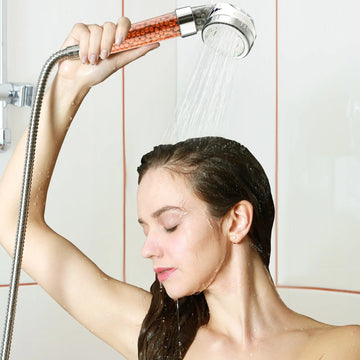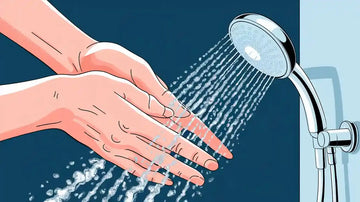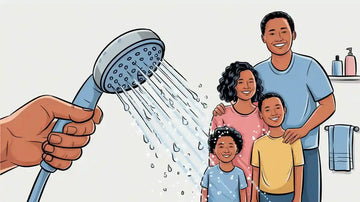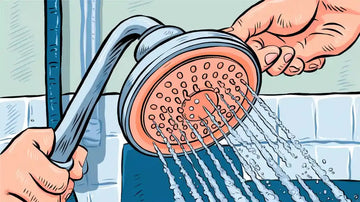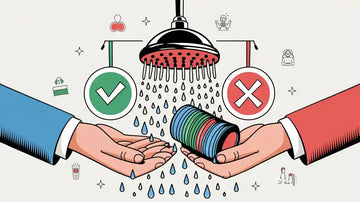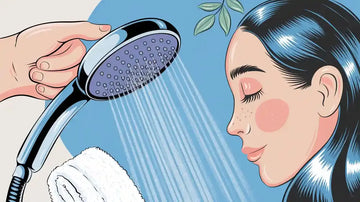"I never thought my skin could feel this smooth again after years of battling hard water." You might wonder if switching to a shower head for hard water can really make a difference. Many people share stories about how their skin felt dry and itchy before making the change. After using a shower head for hard water, you may notice softer skin and fewer problems. Real users say the results feel amazing.
Key Takeaways
Hard water can make your skin dry and itchy. It leaves minerals that block pores and take away natural oils.
A filtered shower head can lower chlorine and other bad stuff. This makes your skin feel softer and less itchy.
Many people notice their skin is less dry and red after a few weeks. Their hair also looks healthier after switching.
For the best results, pick a good filtered shower head. Change the filter often and clean it regularly.
Filtered shower heads are simple to put in. They can make showers nicer and help protect sensitive skin.
Hard Water & Skin
Common Issues
If you live where there is hard water, your skin might feel dry or itchy after showers. Hard water has minerals like calcium and magnesium. These minerals can upset your skin’s normal balance. When you wash, hard water leaves small bits on your skin. These bits can make your skin rough and cause it to get irritated.
The minerals in hard water mess up your skin’s pH and hurt its barrier.
Mineral bits can cause tiny irritations and make soap not work as well.
Studies say people in hard water places get more eczema, especially babies.
Research from the University of Sheffield shows hard water raises skin pH and causes small skin damage.
Clinical trials say water filters can help stop itching and swelling for people with sensitive skin.
Your skin might feel tight or flaky after you shower. If your skin is sensitive, these problems can get worse. Hard water can block your pores and take away your skin’s natural oils. This makes your skin drier, redder, and can cause breakouts. People with sensitive skin often say their skin feels sore or looks red after using hard water.
User Complaints
Many people talk about how hard water hurts their skin. Here are some common things people say:
Study Type |
Population / Sample Size |
Findings |
|---|---|---|
Blood donors in hard water areas |
More dry skin (xerosis) than people in soft water areas |
|
Interventional Study |
36 adult women |
Hard water caused more redness and dry skin than soft water |
Interventional Study |
8 patients with atopic dermatitis |
Using water without minerals for 28 days helped dryness, itching, and scaling |
Epidemiological Studies |
Thousands of children (4-12 years) |
More eczema found in places with hard water |
You might feel itchy or dry skin, especially if you have sensitive skin. Some people say their skin gets red or flaky. Others say their skin feels rough or bumpy after showers. If you have sensitive or eczema-prone skin, hard water can make it worse. Many people feel upset and want an easy solution.
User Experiences
Before Using a Shower Head for Hard Water
You might notice your skin feels dry, itchy, or even a little bumpy after every shower. Many people say their hair turns straw-like and their skin looks red or flaky. If you have sensitive skin, these problems can get worse. Hard water leaves behind soap residue that is tough to rinse off. This residue can clog your pores and strip away your skin’s natural oils. You may see more breakouts or even patches of eczema or psoriasis.
Here’s a quick look at what you might face before using a filtered shower head:
Skin Condition |
Impact |
|---|---|
Dry and Itchy Skin |
Minerals in hard water remove natural oils, leading to dryness and itchiness. |
Acne Breakouts |
Soap scum from hard water clogs pores, causing acne. |
Eczema and Psoriasis |
Hard water worsens these conditions, increasing skin irritation and sensitivity. |
You may also find that soap does not lather well, so you use more of it. This can leave your skin feeling tight and uncomfortable. Some users say, “My skin always felt rough, no matter how much lotion I used.” Others mention, “I had constant breakouts and nothing seemed to help.” If you have a sensitive skin type or a family history of eczema, hard water can make things even harder. Studies show that children with certain genes get more eczema when exposed to hard water.
“I used to dread showers because my skin would itch for hours afterward. My hair felt like straw, and my face broke out all the time.”
After Switching
When you switch to a filtered shower head for hard water, you may notice changes pretty quickly. Many users say their skin feels softer and less irritated within just a few weeks. You might see less redness and fewer breakouts. Some people even say their hair feels smoother and easier to manage.
You may feel relief from dryness and itching.
Your skin can look brighter and feel smoother.
Many users report fewer flare-ups of eczema or psoriasis.
You might use less lotion and fewer creams.
Here are some real stories from users:
“Within two weeks of installing a filtered shower head, my skin stopped itching and my hair felt so much softer.”
“I noticed my breakouts started to clear up after just a few showers. My skin feels clean, not tight or dry.”
Filtered shower heads do not technically soften water. They do not remove all the minerals that make water hard. However, filtered shower heads can reduce chlorine and some impurities. This helps your skin keep its natural oils and moisture. Many users say they feel a big difference, even if the water is still technically hard.
You might wonder why filtered shower heads work so well. The answer is simple. Filtered shower heads trap some of the things that make your skin feel bad, like chlorine and heavy metals. This means less irritation for your skin and hair. You may not get rid of every problem, but most users say they feel much better after making the switch.
Note: Filtered shower heads and showerhead filters come in many types. Some use special media to trap more impurities. Others focus on easy cleaning or multiple spray settings. You can find filtered shower heads that fit almost any shower.
If you have sensitive or sensitive skin, you may see the biggest changes. Many users with eczema or psoriasis say filtered shower heads help calm their skin. Even if you do not have a skin condition, you might just enjoy showers more. Your skin can feel softer, your hair can look shinier, and you may not need as many products.
Filtered shower heads and showerhead filters do not solve every problem, but they can make a big difference. You might find yourself looking forward to showers again!
Filtered Shower Head Results
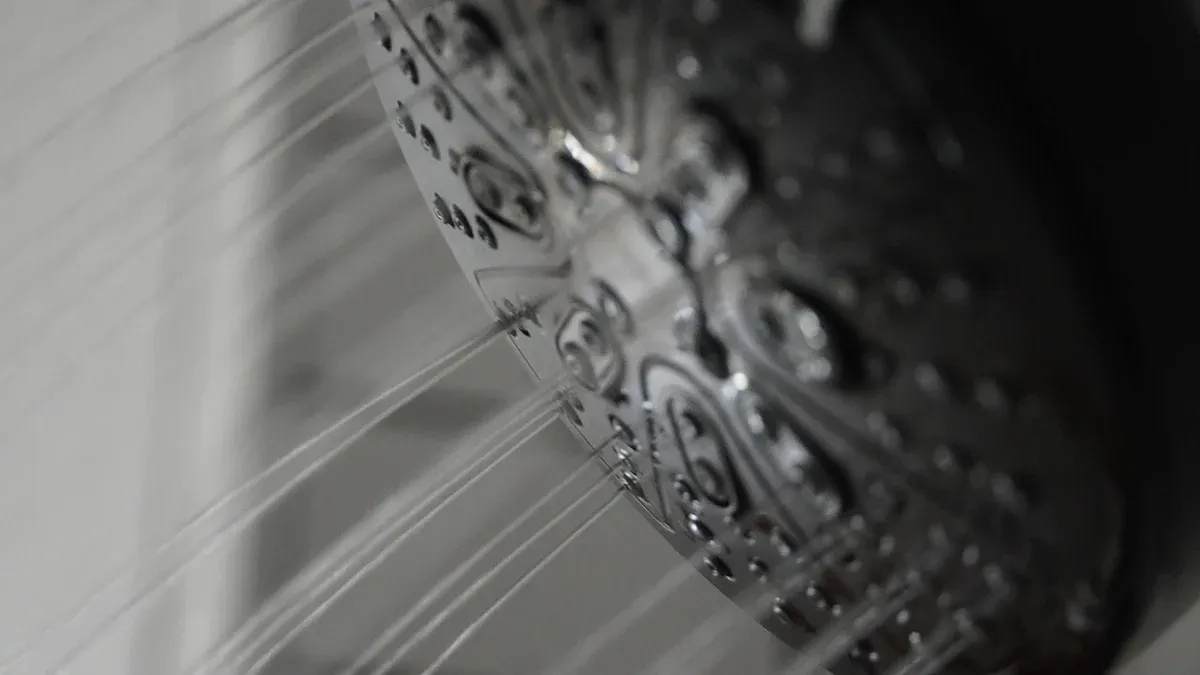
Timeline of Changes
When you use a filtered shower head, you might want to know when you’ll see changes. Most people notice their skin and hair feel better in the first few weeks. Your skin may get softer and less itchy after a few showers. Some people even feel a difference after just one use.
Let’s see what real users say about filtered shower heads:
Improvement Type |
Percentage Reporting Improvement |
Time Frame |
Source Type |
|---|---|---|---|
Less hair shedding |
After 4 weeks |
Clinical data from 1427 reviews |
|
Less hair frizz |
60% |
After 4 weeks |
Clinical data |
Reduction in dry skin |
97% |
After 4 weeks |
Clinical data |
Reduction in acne |
71% |
After 4 weeks |
Clinical data |
Skin clearing and better hair |
N/A |
Under 1 week |
User testimonial (Bonnie F.) |
Fuller, softer, healthier hair |
N/A |
Within 1 week |
User testimonial (Wesley M.) |
Noticeable difference in hair condition |
N/A |
After 1 use |
User testimonial (Kelly B.) |
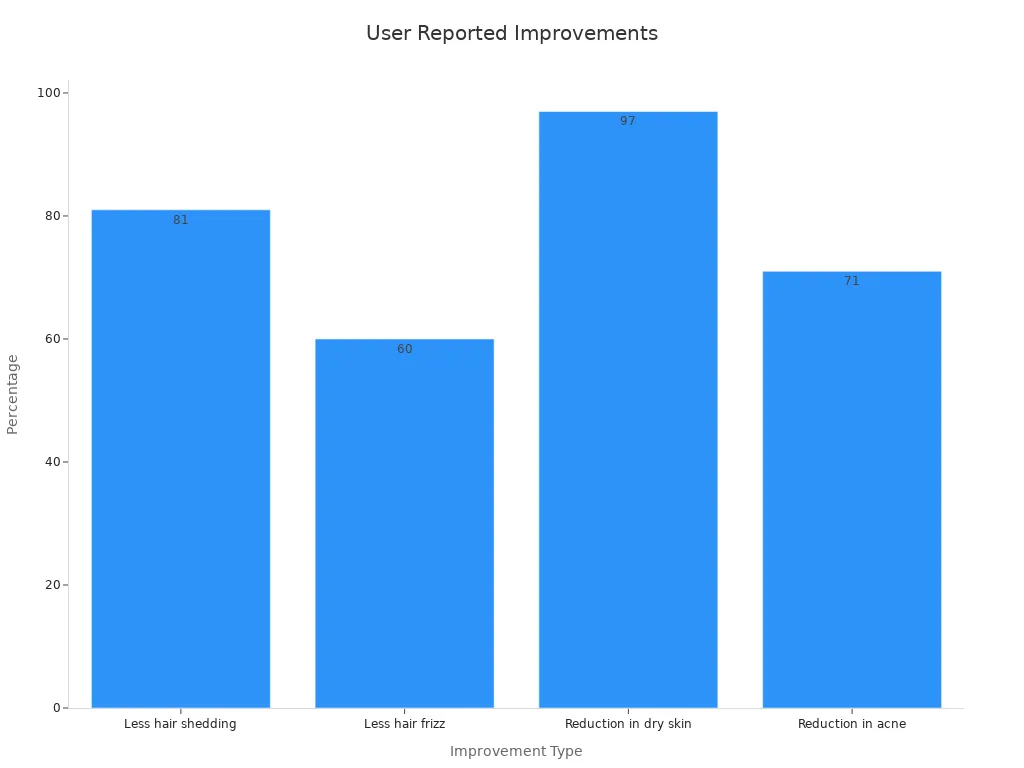
You will probably see the biggest changes in dry skin, hair shedding, and acne in the first month. Many people say their skin feels smoother and their hair looks healthier after a few weeks. If you have sensitive skin or eczema, you might feel less itching and redness even sooner.
Some studies show that skin can start to look better at the end of treatment and even more after one month. By three months, most people see bigger changes in how their skin feels and looks. The longer you use your filtered shower head, the better your results can get.
Factors Affecting Results
Your results with a filtered shower head depend on a few things. The quality of your water, the type of filter, and how well you take care of your shower head all matter.
Water Quality: If your water has lots of chlorine or heavy metals, you might see bigger changes. Filtered shower heads help by taking out these chemicals. They do not remove all the minerals that make water hard. You may still notice some effects of hard water, but less chlorine and fewer impurities can help your skin and hair.
-
Filtration Type: Not all filtered shower heads work the same way. Some use KDF-55, activated carbon, or calcium sulfite to trap chlorine and heavy metals. The kind of filter changes how much chlorine gets removed. For example:
Filter Brand
Chlorine Reduction (%)
Water Volume Filtered (gallons)
Approximate Number of Showers Filtered
90
10,000
588
Crystal Quest
72-89
500
29
You want a filtered shower head that removes a lot of chlorine for the best results. Some filters last longer and keep working well. Always check for certifications and third-party tests to make sure your filter works.
Maintenance: You need to change the filter often to keep your filtered shower head working well. If you forget, the filter won’t work as well and you might not see the same changes. Most brands say to change the filter every few months, depending on your water and how much you shower.
Tip: Mark your calendar or set a phone reminder so you remember to change your filter!
Filtration Limits: Filtered shower heads mostly lower chlorine and some impurities. They do not make water soft by removing calcium and magnesium. You may still notice some hard water effects, but less chlorine and fewer heavy metals can help your skin and hair.
Microbial Levels: Studies show filtered shower heads do not lower bacteria in your shower water. The main help comes from removing chemicals, not germs. If you worry about germs, clean your shower head often.
User Experience: Your results may be different from others. Some people see changes fast, while others need more time. If your water is very hard, you might need a stronger filter or a different type for the best results.
Filtered shower heads are an easy way to make your water better and help your skin and hair. You get the best results by picking the right filter, keeping up with filter changes, and knowing what these filters can and cannot do.
Best Filtered Showerheads
Top Picks
It can be hard to pick the right filtered shower head. But there are some really good choices. Many filtered shower heads are easy to put in and work well. Here are some of the best filtered shower heads that people like:
Product Name |
Chlorine Removal |
Flow Rate (GPM) |
Filter Lifespan |
Certification |
User Ratings |
|---|---|---|---|---|---|
Aquasana Shower Filter |
Up to 2.5 |
Not specified |
NSF/ANSI 177 |
4.5+ stars |
|
WaterChef SF-7C |
1.43 |
8,000 gallons |
NSF/ANSI Certified |
4.7 stars |
|
99% (multi-stage) |
1.5–2.5 |
3–6 months |
Not specified |
||
Jolie Filtered Showerhead |
84–85% (claimed) |
Not specified |
~3 months |
No NSF certification |
Highly rated |
Weddell Duo Shower Filter |
Certified |
1.43 |
8,000 gallons |
NSF/ANSI 177 |
4.6 stars |
Filtered shower heads with KDF-55, calcium sulfite, and activated carbon get great reviews. People say these filtered shower heads help stop dry skin and hair loss. They also help with skin that feels itchy or sore. Many filtered shower heads let you pick different spray settings. This makes your shower feel like a spa at home.
“After I got a filtered shower head, my skin stopped itching. My hair is softer now, and I like the water pressure!”
User Tips
You want your filtered shower head to work well. Here are some tips to help you get the best results:
Change your showerhead filter every 3–6 months, or sooner if water slows down.
Pick filtered shower heads with NSF/ANSI 177 certification for better chlorine removal.
Choose filtered shower heads that are easy to install and have simple filter changes.
Try a filtered shower head with more than one spray mode for comfort.
Clean your filtered shower head often to stop buildup and keep it working.
Use hydrating lotion after showers to help your skin even more.
Doctors say filtered shower heads are good for people with sensitive skin or hair problems. Studies show filtered shower heads protect your hair from minerals and help your skin stay soft. Filtered shower heads with KDF-55 and multi-stage filters work best. If you want an easy upgrade, filtered shower heads are a smart pick. You can get softer skin, healthier hair, and enjoy your shower more each day.
You can see real changes in your skin and hair when you use a filtered shower head for hard water. Many users notice softer skin, less dryness, and shinier hair. Here’s what you might experience:
Softer, smoother skin
Less irritation and dryness
Healthier scalp and less dandruff
If you struggle with hard water, give a filtered shower head a try. Have you noticed a difference? Share your story or ask a question below!
FAQ
How often should you change your shower head filter?
You should change your filter every 3 to 6 months. If your water flow slows down or your skin feels dry again, swap it sooner. Mark your calendar so you don’t forget!
Can a filtered shower head help with hair loss?
A filtered shower head can help reduce hair breakage and dryness. Many users say their hair feels softer and sheds less. It may not stop hair loss from other causes, but it can make your hair healthier.
Do filtered shower heads remove all hard water minerals?
Filtered shower heads mostly remove chlorine and some metals. They do not take out all calcium and magnesium. You may still have some hard water effects, but your skin and hair will likely feel better.
Will a filtered shower head lower my water pressure?
Most filtered shower heads keep good water pressure. If you notice a drop, check for clogs or change the filter. Clean your shower head often to keep the water flowing strong.
Is it easy to install a filtered shower head?
Yes! You can usually install one in minutes with no tools. Just unscrew your old shower head and screw on the new one. Most brands include simple instructions.
